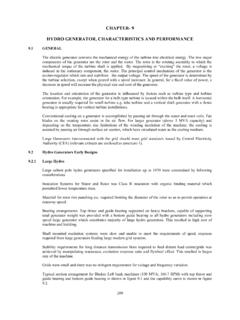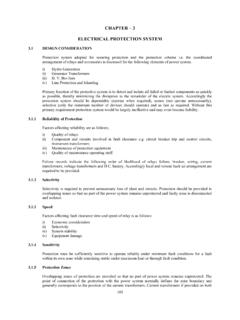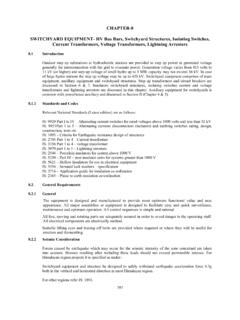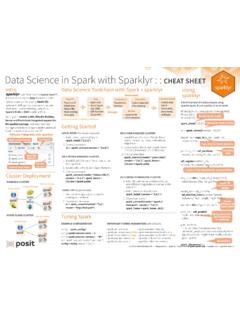Transcription of LECTURE 2: DATA (PRE-)PROCESSING
1 LECTURE 2: data (PRE-)PROCESSINGDr. DhavalPatel CSE, In Previous Class, We discuss various type of data with examples In this Class, We focus on data pre- processing an important milestone of the data Mining Process data analysis pipeline Mining is not the only step in the analysis process Preprocessing: real data is noisy, incomplete and inconsistent. data cleaning is required to make sense of the data Techniques: Sampling, Dimensionality Reduction, Feature Selection. Post- processing : Make the data actionable and useful to the user : Statistical analysis of importance & PreprocessingData MiningResult Post-processingData Preprocessing Attribute Values Attribute Transformation Normalization (Standardization) Aggregation Discretization Sampling Dimensionality Reduction Feature subset selection Distance/Similarity Calculation VisualizationAttribute ValuesData is described using attribute valuesAttribute Values Attribute values are numbersor symbolsassigned to an attribute Distinction between attributes and attribute values Same attribute can be mapped to different attribute values Example.
2 Height can be measured in feet or meters Different attributes can be mapped to the same set of values Example: Attribute values for ID and age are integers But properties of attribute values can be different ID has no limit but age has a maximum and minimum valueTypes of Attributes There are different types of attributes Nominal Examples: ID numbers, eye color, zip codes Ordinal Examples: rankings ( , taste of potato chips on a scale from 1-10), grades, height in {tall, medium, short} Interval Examples: calendar dates Ratio Examples: length, time, counts Types of Attributes Attribute LevelTransformationCommentsNominalAny permutation of valuesIf all employee ID numbers were reassigned, would it make any difference?
3 OrdinalAn order preserving change of values, , new_value = f(old_value) where fis a monotonic attribute encompassing the notion of good, better best can be represented equally well by the valuesIntervalnew_value =a * old_value + b where a and b are constantsCalendar dates can be converted financial vs. Gregorian = a * old_valueLength can be measured in meters or and Continuous Attributes Discrete Attribute Has only a finite or countable infinite set of values Examples: zip codes, counts, or the set of words in a collection of documents Often represented as integer variables. Continuous Attribute Has real numbers as attribute values Examples: temperature, height, or weight.
4 Practically, real values can only be measured and represented using a finite number of QualityData has attribute valuesThen,How good our data these attribute values? data Quality Examples of data quality problems: Noise and outliers missing values Duplicate data Tid Refund Marital Status Taxable Income Cheat 1 Yes Single 125K No 2 No Married 100K No 3 No Single 70K No 4 Yes Married 120K No 5 No Divorced 10000K Yes 6 No NULL 60K No 7 Yes Divorced 220K NULL 8 No Single 85K Yes 9 No Married 90K No 9 No Single 90K No 10 A mistake or a millionaire? missing valuesInconsistent duplicate entriesData Quality: Noise Noise refers to modification of original values Examples: distortion of a person s voice when talking on a poor phone and snow on television screenTwo Sine WavesTwo Sine Waves + NoiseFrequency Plot (FFT) data Quality: Outliers Outliers are data objects with characteristics that are considerably different than most of the other data objects in the data setData Quality.
5 missing Values Reasons for missing values Information is not collected ( , people decline to give their age and weight) Attributes may not be applicable to all cases ( , annual income is not applicable to children) Handling missing values Eliminate data Objects Estimate missing Values Ignore the missing value During Analysis Replace with all possible values (weighted by their probabilities) data Quality: Duplicate data data set may include data objects that are duplicates, or almost duplicates of one another Major issue when merging data from heterogeoussources Examples: Same person with multiple email addresses data cleaning Process of dealing with duplicate data issuesSFU, CMPT 741, Fall 2009, Martin Ester16 data Quality: Handle Noise(Binning) Binning sort data and partition into (equi-depth) bins smooth by bin means, bin median, bin boundaries, etc.
6 Regression smooth by fitting a regression function Clustering detect and remove outliers Combined computer and human inspection detect suspicious values automatically and check by humanSFU, CMPT 741, Fall 2009, Martin EsterData Quality: Handle Noise(Binning) Equal-width binning Divides the range into Nintervals of equal size Width of intervals: Simple Outliers may dominate result Equal-depth binning Divides the range into Nintervals, each containing approximately same numberof records Skewed data is also handled wellSimple Methods: BinningExample: customer ages0-1010-2020-3030-4040-5050-6060-7070 -80 Equi-width binning:numberof values0-2222-3144-4832-3838-4448-5555-62 62-80 Equi-width binning: data Quality: Handle Noise(Binning)Example: Sorted price values 4, 8, 9, 15, 21, 21, 24, 25, 26, 28, 29, 34* Partition into three (equi-depth) bins-Bin 1: 4, 8, 9, 15-Bin 2: 21, 21, 24, 25-Bin 3: 26, 28, 29, 34* Smoothing by bin means-Bin 1: 9, 9, 9, 9-Bin 2: 23, 23, 23, 23-Bin 3: 29, 29, 29, 29* Smoothing by bin boundaries-Bin 1: 4, 4, 4, 15-Bin 2: 21, 21, 25, 25-Bin 3: 26, 26, 26, 34 data Quality.
7 Handle Noise(Regression) Replacenoisyormissingvaluesbypredictedva lues Requiresmodelofattributedependencies(may bewrong!) Canbeusedfordatasmoothingorforhandlingmi ssingdataxyy = x + 1X1Y1Y1 data QualityThere are many more noise handling techniques .. > ImputationData TransformationData has an attribute valuesThen,Can we compare these attribute values? For Example: Compare following two records(1) ( ft,50 Kg) (2) ( ft, 55 Kg)Vs. (3) ( ft,50 Kg)(4) ( ft, 56 Kg)We need data Transformation to makes different dimension(attribute) records comparable .. data Transformation Techniques Normalization: scaled to fall within a small, specified range.
8 Min-max normalization z-score normalization normalization by decimal scaling Centralization: Based on fitting a distribution to the data Distance function between distributions KL Distance Mean CenteringData Transformation: Normalization min-max normalization z-score normalization normalization by decimal scalingminnewminnewmaxnewminmaxminvv_)__ (' devstandmeanvv_' jvv10' Where jis the smallest integer such that Max(| |)<1'vExample: data Transformation-Assume, min and max value for height and weight. -Now, apply Min-Max normalization to both attributes as given follow(1) ( ft,50 Kg) (2) ( ft, 55 Kg)Vs.
9 (3) ( ft,50 Kg)(4) ( ft, 56 Kg)-Compare your Transformation: Aggregation Combining two or more attributes (or objects) into a single attribute (or object) Purpose data reduction Reduce the number of attributes or objects Change of scale Cities aggregated into regions, states, countries, etc More stable data Aggregated data tends to have less variability SFU, CMPT 741, Fall 2009, Martin Ester27 data Transformation: Discretization Motivation for Discretization Some data mining algorithms only accept categorical attributes May improve understandability of patternsSFU, CMPT 741, Fall 2009, Martin Ester28 data Transformation: Discretization Task Reduce the number of values for a given continuous attributeby partitioning the range of the attribute into intervals Interval labels replace actual attribute values Methods Binning (as explained earlier) Cluster analysis (will be discussed later) Entropy-based Discretization(Supervised)Simple Discretization Methods: Binning Equal-width(distance) partitioning.
10 Divides the range into Nintervals of equal size: uniform grid if Aand Bare the lowest and highest values of the attribute, the width of intervals will be: W = (B A)/N. The most straightforward, but outliers may dominate presentation Skewed data is not handled well. Equal-depth(frequency) partitioning: Divides the range into Nintervals, each containing approximately same number of samples Good data scaling Managing categorical attributes can be Given probabilititesp1, p2, .., pswhose sum is 1, Entropyis defined as: Entropy measures the amount of randomness or surprise or uncertainty. Only takes into account non-zero probabilitiesEntropy-Based Discretization Given a set of samples S, if S is partitioned into two intervals S1 and S2 using boundary T, the entropy after partitioning is The boundary that minimizes the entropy function over all possible boundaries is selected as a binary discretization.










